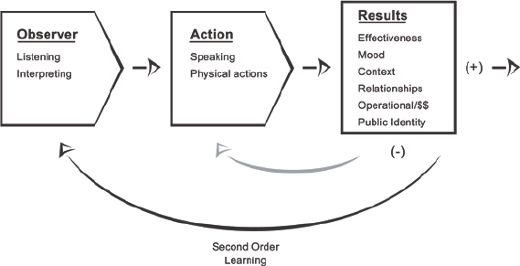The Observer-Action-Results (OAR) model is at the heart of ontological coaching.
First-order Learning
Each of us take action (speaking or physical actions) to get results (effectiveness, mood, context, public identity, etc). If the desired result is achieved, you might repeat the same action. If the results are not satisfactory, you might look at what other actions you could try in hopes of getting the results you want.
This is first order learning and is something that is traditionally taught.

This implies that there is an objective problem that exists and the right action is needed to solve them.
Second Order Learning
There is a more powerful form of learning available.
Instead of looking at possible actions to try to get a desired result, you can look at yourself to observe how you observe. Change how you observe and you can see new actions or possibilities that you could not before.
The way each person observes the world determines the set of possible actions available or visible to them. If you can understand how you observe the world, you can consciously choose to observe in a different way to see new possibilities.
Seeing more possibilities for action provides choice because it allows you to choose whether to take any of these actions or not. If you can’t see it as a possibility, the choice to take an action is simply not available.
Each of us is a unique observer of our surroundings, and no two people will see the world in the same way. Have you ever struggled with a problem that was solved after a 5 minute conversation with someone else?

For example, if I am working and want to earn more money, the actions that I see are: getting promoted or finding a different job. Someone else might see these same 2 possible actions but they may add one more: “setting up your own business”. What is it about my way of being such that setting up a business isn’t even on the radar screen of possibilities? A possible answer is that I see the world as a place full of dangers, while the other person sees the world as a place full of opportunities. This is a belief about the world that lives in language.
Way Of Being
You may take many different actions to achieve different results.
However, all the actions you take ultimately come from the same observer (yourself) - the same way of seeing things, the same perspective.
Looking at how each of us observes takes us closer to an exploration about who we say we are and “be”,, less about any particular thing you’re doing. Here are some different ways of seeing the world - operating from different orientations will result in different sets of actions being available:
- “I am enough” vs “I am not enough”
- “The world is full of danger” vs “The world is full of opportunities”
- “I am whole” vs “I am not whole / flawed”
- Be-do-have vs have-do-be
We observe the world through distinctions. Distinctions make us aware of things that stand out. E.g, a software engineer is able to get more information from a piece of code than someone who does not code. Teaching someone your job is about teaching them the distinctions that you’ve acquired.
What distinctions are worth learning to become a more powerful observer? Powerful in this sense is the capacity for taking more effective action.
An answer provided by ontological coaching is distinctions to understand our way of being - what it means to be human. These distinctions help us understand “why do I observe things in the way that I do”. Hence, second-order learning considers our way of being.